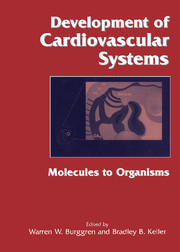Book contents
- Frontmatter
- Contents
- List of contributors
- Foreword by Constance Weinstein
- Introduction: Why study cardiovascular development?
- Part I Molecular, cellular, and integrative mechanisms determining cardiovascular development
- Part II Species diversity in cardiovascular development
- 9 Evolution of cardiovascular systems: Insights into ontogeny
- 10 Morphogenesis of vertebrate hearts
- 11 Invertebrate cardiovascular development
- 12 Piscine cardiovascular development
- 13 Amphibian cardiovascular development
- 14 Reptilian cardiovascular development
- 15 Avian cardiovascular development
- 16 Mammalian cardiovascular development: Physiology and functional reserve of the fetal heart
- Part III Environment and disease in cardiovascular development
- Epilogue: Future directions in developmental cardiovascular sciences
- References
- Systematic index
- Subject index
12 - Piscine cardiovascular development
from Part II - Species diversity in cardiovascular development
Published online by Cambridge University Press: 10 May 2010
- Frontmatter
- Contents
- List of contributors
- Foreword by Constance Weinstein
- Introduction: Why study cardiovascular development?
- Part I Molecular, cellular, and integrative mechanisms determining cardiovascular development
- Part II Species diversity in cardiovascular development
- 9 Evolution of cardiovascular systems: Insights into ontogeny
- 10 Morphogenesis of vertebrate hearts
- 11 Invertebrate cardiovascular development
- 12 Piscine cardiovascular development
- 13 Amphibian cardiovascular development
- 14 Reptilian cardiovascular development
- 15 Avian cardiovascular development
- 16 Mammalian cardiovascular development: Physiology and functional reserve of the fetal heart
- Part III Environment and disease in cardiovascular development
- Epilogue: Future directions in developmental cardiovascular sciences
- References
- Systematic index
- Subject index
Summary
Introduction
Fish offer a number of distinct advantages as experimental animals in which to study the development of the vertebrate cardiovascular system. Development is external, and the embryo is transparent in most species, making microscopic examination and manipulation of the living embryo relatively easy. Many common aquarium species are easy to rear, produce large numbers of eggs, and have short generation times. These advantages have led to a surge in interest in recent years in using fish, in particular the zebra fish Danio (Brachydanio) rerio, as an animal model for studying the development of vertebrate organ systems (Baiter, 1995). One of the more promising techniques to be applied to the study of the cardiovascular system involves induced mutation and subsequent isolation of genes acting at various stages in the developmental cascade (see Chapter 1). Profound mutations, such as the failure of the heart to form, are readily obvious and require little knowledge of normal morphogenetic events. However, identification of subtler effects, particularly functional changes, requires that the investigator have a good knowledge of normal development. Unfortunately, such information is not always readily available. The goal of this chapter is to provide an overview of current knowledge regarding piscine cardiovascular development that will assist investigators in both the planning and the interpretation of their experiments. Where possible, I have attempted to place developmental events in the context of eventual adult function.
In examining the role of the cardiovascular system during development, it is important to recognize that embryos and larvae are not simply small adults.
- Type
- Chapter
- Information
- Development of Cardiovascular SystemsMolecules to Organisms, pp. 145 - 165Publisher: Cambridge University PressPrint publication year: 1998



